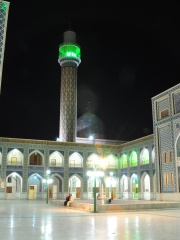


The Most Famous
RELIGIOUS FIGURES from Yemen
This page contains a list of the greatest Yemeni Religious Figures. The pantheon dataset contains 3,187 Religious Figures, 3 of which were born in Yemen. This makes Yemen the birth place of the 71st most number of Religious Figures behind Democratic Republic of the Congo, and Libya.
Top 3
The following people are considered by Pantheon to be the most legendary Yemeni Religious Figures of all time. This list of famous Yemeni Religious Figures is sorted by HPI (Historical Popularity Index), a metric that aggregates information on a biography's online popularity.

1. Uwais al-Qarani (594 - 657)
With an HPI of 73.09, Uwais al-Qarani is the most famous Yemeni Religious Figure. His biography has been translated into 27 different languages on wikipedia.
ʾUways ibn ʿĀmir al-Qaranī (Arabic: أُوَيْس ٱبْن عَامِر ٱلْقَرَنِيّ) was Muslim military commander and one of the tabi'in who served in the Rashidun Caliphate. As a tabi'i, he never met the Prophet Muhammad, though was sometimes honorarily counted as among the companions. He was a loyal companion of Ali, and was a commander in Ali's army at the Battle of Siffin, where he was killed in 657. He's venerated by Shi'ites and Sunnis alike, and the Sufi Uwaysi tradition is named after him. Among the Tabi'un, he is specially known as Khayr at-Tābiʿīn (Arabic: خَيْر ٱلتَّابِعِين, lit. 'the best of the Tabi‘un') and Sayyid at-Tabiʿīn fī Zamānah (Arabic: سَيِّد ٱلتَّابِعِين فِي زَمَانَه, lit. 'leader of the Tabi‘un of his era').

2. Abdullah ibn Saba' (700 - 700)
With an HPI of 66.74, Abdullah ibn Saba' is the 2nd most famous Yemeni Religious Figure. Her biography has been translated into 22 different languages.
ʿAbd Allāh ibn Sabāʾ al-Ḥimyarī (Arabic: عبد الله بن سبأ الحميري), sometimes also called Ibn Sabāʾ, Ibn al-Sawdāʾ, or Ibn Wahb, was a 7th-century figure in Islamic history associated with a group of followers called the Sabaʾiyya (سبئية). According to Sunni and Shia tradition, Abd Allah ibn Saba' was a Yemenite Jew from the Arab Himyar tribe who converted to Islam during Uthman's reign. Because of his exaggerated reverence for Ali, he is traditionally considered as the first of the ghulāt. In accounts collected by Sayf ibn Umar, Ibn Saba' and his followers, the Saba'iyya, are said to be the ones who enticed the Egyptians against Uthman and were responsible for breaking the near-settlement at the Battle of the Camel. Modern historians differed on the historicity of Ibn Saba'. Some believe that Abd Allah ibn Saba' and Ibn al-Sawdāʾ should be considered as two separate individuals (Hodgson). Some have described him as semi-legendary or legendary (Taha Hussein, Bernard Lewis, Wilferd Madelung, Leone Caetani, and Shia historians). Others such as Israel Friedlander, Sabatino Moscati, and Sunni historians affirm his existence. His Jewish origin has also been contested. Some modern historians assert that Sayf ibn Umar fabricated the episode about the killing of Uthman to "exonerate the people of Medina from participation in the caliph's murder" and the movement to support Ali as a successor to Muhammad did not exist in the time of Uthman. With the exception of Taha Hussein, most modern Sunni writers affirm the existence of Ibn Saba'. Anthony affirms the existence of Ibn Saba' as the one who articulated the doctrine of the return of Ali.

3. Malik al-Ashtar (585 - 658)
With an HPI of 66.52, Malik al-Ashtar is the 3rd most famous Yemeni Religious Figure. His biography has been translated into 20 different languages.
Malik al-Ashtar (Arabic: مَالِك ٱلْأَشْتَر), romanized: Mālik al-Ashtar), born Mālik ibn al-Ḥārith al-Nakhaʿī al-Madhḥijī (Arabic: مَالِك ٱبْن ٱلْحَارِث ٱلنَّخَعِيّ ٱلْمَذْحِجِيّ), was an Arab Muslim military commander and tribal leader of the Nakha branch of the Madhḥij confederation. He was active in the political and military events of the Rashidun Caliphate. Malik gained prominence for his leadership role in several campaigns and for his influence within the armies of the period, including in the Battle of the Yarmuk. He was later appointed governor of Egypt but died on the way there in 658 CE (38 AH). Malik rose to prominence during the caliphate of Ali and as one of his key allies, took part in the main battles of the First Fitna, including the Battle of Jamal, the Battle of Siffin against Mu'awiya, and the Battle of Nahrawan, where he served as a cavalry commander.
People
Pantheon has 3 people classified as Yemeni religious figures born between 585 and 700. Of these 3, none of them are still alive today. The most famous deceased Yemeni religious figures include Uwais al-Qarani, Abdullah ibn Saba', and Malik al-Ashtar.
Deceased Yemeni Religious Figures
Go to all RankingsUwais al-Qarani
594 - 657
HPI: 73.09
Abdullah ibn Saba'
700 - 700
HPI: 66.74
Malik al-Ashtar
585 - 658
HPI: 66.52

